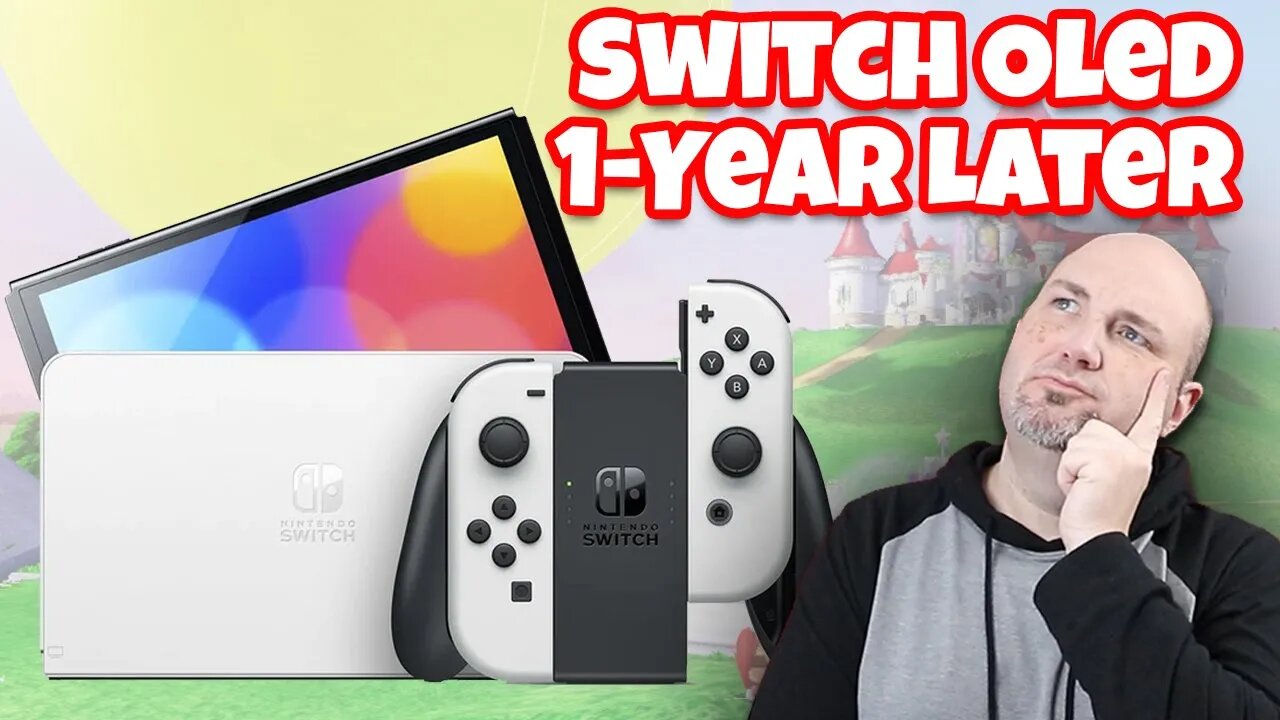Premium Only Content

Nintendo Switch OLED - 1 Year Later Is It Still Good?
In this episode, we talk about the one-year anniversary of the launch of the Nintendo Switch OLED!
Check out our unboxing and review of the Nintendo Switch OLED at https://youtu.be/Uqib2zdC9v8
It is hard to believe that the Switch OLED is already one year old, but then again the original Switch itself is five and a half years old at this point! In that year, I spent a lot of time playing the Switch OLED, in fact, it has become my primary Nintendo switch. But looking back over the course of the last year is this still something I'm glad that I have in my collection?
The Switch OLED definitely has some improvements over the original version. First of all, you cannot look at those two screens and not see an immediate difference in the OLED, it is so much sharper, so much brighter, and just a little bit larger. When I have had to film videos gorilla-style looking at the screen, the Switch OLED does a much better job and shows up on the camera a lot better. You can't deny the quality of this screen. Other enhancements include much better audio, that updated kickstand back, and of course the ethernet port built into the dock. Out of all of these the one that I have used the least is the ethernet connection, as I have really good Wi-Fi in my home so, for me at least, I kind of wish I had that extra USB port back.
Between the original Switch and the Switch OLED, I will say that the docked experience seems by and large unchanged to me. And that makes sense, Nintendo didn't tweak the internals of the Switch OLED from the original. The focus was a better screen with better audio and a better kickstand, and unfortunately, we did not get an improvement in the Tegra processor from Nvidia, more RAM, or anything that would perform faster or cooler.
Handheld mode is really where the Switch OLED shines, literally and figuratively. The visuals are so much better on this than on the original version it's really remarkable. And I've mentioned this in other videos but one thing that doesn't get talked about enough is the enhanced audio on the Switch OLED, it's so much better sounding, so much richer, and deeper. If you are looking for the best handheld switch experience that you can get, the Switch OLED is where it is at.
Alongside the Switch OLED, Nintendo launched Metroid Dread, a game I purchased at the same time but have still yet to crack the seal on. Everything I've seen and heard is that this is a marvelous game, I just have not had time to pull this one out of my backlog. It was good, however, that Nintendo did give the Switch OLED significance with a launch title as well.
So am I still glad that I bought the switch OLED a year later? Kinda, but not really. I don't play on handheld mode a whole lot, it's just not my preferred way to play. I want to play on my television so for me most of the Switch OLED enhancements are lost. If I didn't have this YouTube channel I probably would not have purchased one, to be honest. From a content creator standpoint, I appreciate the fact that the OLED display is gorgeous and much easier to film, but from a gamer's perspective, it doesn't do much for me. Someday I hope Nintendo releases a consolized version of the Nintendo Switch, something with enhanced performance and visuals for a 4K TV, but until then I will have to wait.
#Nintendo #switcholed #SuperMario
The footage used in this review are used under the Fair Use laws, referenced below:
https://www.law.cornell.edu/uscode/text/17/107
Notwithstanding the provisions of sections 106 and 106A, the fair use of a copyrighted work, including such use by reproduction in copies or phonorecords or by any other means specified by that section, for purposes such as criticism, comment, news reporting, teaching (including multiple copies for classroom use), scholarship, or research, is not an infringement of copyright. In determining whether the use made of a work in any particular case is a fair use the factors to be considered shall include—
(1) the purpose and character of the use, including whether such use is of a commercial nature or is for nonprofit educational purposes;
(2) the nature of the copyrighted work;
(3) the amount and substantiality of the portion used in relation to the copyrighted work as a whole; and
(4) the effect of the use upon the potential market for or value of the copyrighted work.
The fact that a work is unpublished shall not itself bar a finding of fair use if such finding is made upon consideration of all the above factors.
(Pub. L. 94–553, title I, § 101, Oct. 19, 1976, 90 Stat. 2546; Pub. L. 101–650, title VI, § 607, Dec. 1, 1990, 104 Stat. 5132; Pub. L. 102–492, Oct. 24, 1992, 106 Stat. 3145.)
-
 19:36
19:36
RoXolidProductions
1 month agoNintendo Switch 2 Unboxing & GameStop Launch Highlights
351 -

LimpStinker
2 hours agoZelda BOTW on Switch 2
318 -
 6:18:53
6:18:53
RECON-RAT Guns & Gaming
1 day ago $0.02 earnedRECON-RAT - Battlefield Marathon! - BF1 -BFV - BF2042
5551 -
 1:54:08
1:54:08
The Michelle Moore Show
20 hours ago'Medical Preparedness...Your Gateway to Freedom, Foods Parasites Hate, and more' Guest, Dr. Shawn Rowland, Founder of Jase Medical: The Michelle Moore Show (July 29, 2025)
15.7K9 -
 15:05
15:05
The Pascal Show
12 hours ago $1.56 earnedHOLY SH*T! The Missing Minute From Epstein’s Jail Video Has Been FOUND
9.52K9 -
 LIVE
LIVE
Lofi Girl
2 years agoSynthwave Radio 🌌 - beats to chill/game to
187 watching -
 2:14:32
2:14:32
Inverted World Live
10 hours agoHarvard Astronomer Says Hostile Alien Spaceship Heading Toward Earth | Ep. 82
225K59 -
 2:29:34
2:29:34
Brandon Gentile
4 days agoHow To Retire 10 Years Early with Just 0.1 Bitcoin
12.5K7 -
 3:19:34
3:19:34
Laura Loomer
9 hours agoEP135: Champagne Communism: Zohran Mamdani's Ugandan Compound EXPOSED
53.6K11 -
 28:39
28:39
The Why Files
3 days agoCryptids Vol. 4 | Bunyips, Yowie and Australian Nightmare Fuel
61.2K38